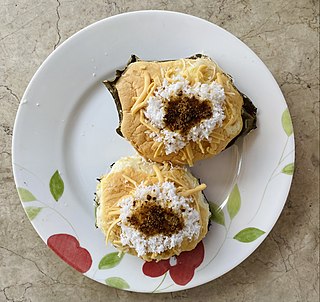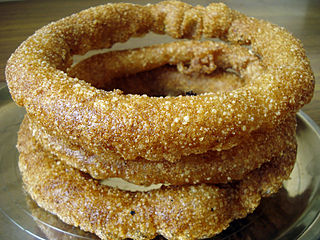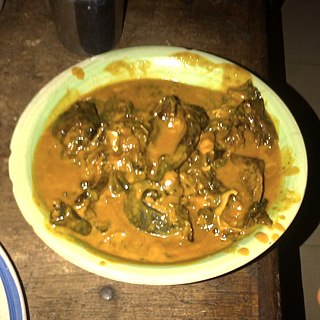Related Research Articles

Cornmeal is a meal ground from dried corn (maize). It is a common staple food and is ground to coarse, medium, and fine consistencies, but it is not as fine as wheat flour can be. In Mexico and Louisiana, very finely ground cornmeal is referred to as corn flour. When fine cornmeal is made from maize that has been soaked in an alkaline solution, e.g., limewater, it is called masa harina, which is used for making arepas, tamales, and tortillas. Boiled cornmeal is called polenta in Italy and is also a traditional dish and bread substitute in Romania.

A pancake is a flat cake, often thin and round, prepared from a starch-based batter that may contain eggs, milk and butter, and then cooked on a hot surface such as a griddle or frying pan. It is a type of batter bread. Archaeological evidence suggests that pancakes were probably eaten in prehistoric societies.

The black-eyed pea or black-eyed bean is a legume grown around the world for its medium-sized, edible bean. It is a subspecies of the cowpea, an Old World plant domesticated in Africa, and is sometimes simply called a cowpea.

In West Africa, garri is the flour of the fresh starchy cassava root.

Bibingka commonly refers to a type of baked rice cake from the Philippines that is traditionally cooked in a terracotta oven lined with banana leaves and is usually eaten for breakfast or as merienda especially during the Christmas season. It is also known as bingka in the Visayas and Mindanao islands.

An uttapam is a type of dosa from South India. Unlike a typical dosa, which is crisp and crepe-like, an uttapam is thicker, with toppings. The name is derived from the Tamil words appam and utthia or uttria, meaning "poured appam", because appam is cooked in a round-bottom pan, whereas utthia-appam is cooked on a flat skillet. Tamil ancient literature mentions it by name. The classic breakfast of Tamil residents consists of idli, dosas or uttappams mostly accompanied by sambar and chutney.

Pithas are a variety of food similar to pancakes, dumplings or fritters, originating from the Indian subcontinent, common in Bangladesh and India. Pitha can be sweet or savoury, and usually made from a dough or batter, which is then steamed, fried or griddled. Very few varieties are oven-baked or boiled, and most are unleavened and cooked on a stovetop. Some versions may have a filling, garnish, or sauce. Few may be set or shaped after cooking. They are typically eaten as a snack with chai, or as treats during special occasions.

Rice flour is a form of flour made from finely milled rice. It is distinct from rice starch, which is usually produced by steeping rice in lye. Rice flour is a common substitute for wheat flour. It is also used as a thickening agent in recipes that are refrigerated or frozen since it inhibits liquid separation.

Kunu is a popular drink consumed throughout Nigeria, mostly in the North. It is usually made from a grain such as millet or sorghum, although it can be made from maize as well. As a grain based beverage Kunu is a member of the Horchata family. The variety of the drink made from sorghum is a milky light-brown colour, whilst that which is made from millet and maize is whitish in colour.

Sel roti is a traditional Nepalese ring-shaped sweet fried dough made from rice flour. It is mostly prepared during Dashain and Tihar, widely celebrated Hindu festivals in Nepal as well as Darjeeling, Kalimpong and Sikkim regions in India. The dish is popular throughout Nepal and among the Indian Gorkha community. Sel roti is made from a batter of rice flour, water, sugar, ghee, and spices which is then deep-fried in cooking oil.

Nigerian cuisine consists of dishes or food items from the hundreds of Native African ethnic groups that comprises Nigeria. Like other West African cuisines, it uses spices and herbs with palm oil or groundnut oil to create deeply flavored sauces and soups.

The Mangalorean Catholic Cuisine is the cuisine of the Mangalorean Catholic community.

A great variety of cassava-based dishes are consumed in the regions where cassava is cultivated.

Malaysian Indian cuisine, or the cooking of the ethnic Indian communities in Malaysia, consists of adaptations of authentic dishes from India, as well as original creations inspired by the diverse food culture of Malaysia. Because the vast majority of Malaysia's Indian community are of South Indian descent, and are mostly ethnic Tamils who are descendants of immigrants from a historical region which consists of the modern Indian state of Tamil Nadu and Sri Lanka's Northern Province, much of Malaysian Indian cuisine is predominantly South Indian inspired in character and taste. A typical Malaysian Indian dish is likely to be redolent with curry leaves, whole and powdered spice, and contains fresh coconut in various forms. Ghee is still widely used for cooking, although vegetable oils and refined palm oils are now commonplace in home kitchens. Before a meal it is customary to wash hands as cutlery is often not used while eating, with the exception of a serving spoon for each respective dish.

Tuwon Shinkafa is a type of Nigerian and Nigerien rice swallow from Niger and the northern part of Nigeria. It is a thick pudding prepared from a local rice that is soft and sticky, and is usually served with different types of soups like Miyar Kuka, Miyar Kubewa, and Miyar Taushe. Two variants made from maize and sorghum flour are called Tuwon Masara and Tuwon Dawa, respectively. In Ghana, Tuwon Shinkafa is called Omo Tuo.

Ofada rice is a Yoruba dish. It is the name of an indigenous rice from a small community called Ofada, located in the Obafemi Owode Local Government Area of Ogun State. It is not exclusively grown in the community, but it is an indigenous rice grown in southwest Nigeria but named after the Ofada community. It is used in making a variety of dishes. Ofada rice are mostly blends, and some of the rice varieties in the blends are not indigenous to Africa; however, they usually also contain African rice. It is grown almost exclusively in Ogun State, a state in southwestern Nigeria. Ofada rice is grown on free-draining soil where the water table is permanently below the root of the plant.

Owo is a soup eaten in the south-central region of Nigeria. It is common among the Urhobo and Isoko. The soup is made with garri soaked in water after palm oil and potash mixture has been added. It is traditionally served at weddings in the Delta State; its absence at a wedding celebration is considered insulting to guests. It is also served at other traditional celebrations.
Dambu is an hausa delicacy made from maize known as tsaki or rice, moringa leaves and carrot. There are different types of dambu, but the most common type is dambu shinkafa; this is the dambu made from rice.
Alkaki is a Hausa doughnut made with wheat and sugar paste or honey, it usually found in Hausa people royal houses and bride houses. Alkaki is a snack originating from Northern Nigeria, known for its pronounced sweetness. This sweetness is achieved by soaking the snack in honey, sugar, or lemon syrup, which imparts moisture to it as it gets absorbed. Alkaki is a well-known choice for both parties and street food.
References
- 1 2 "How to Make Sinasir Recipe - Northpad Nigeria". northpad.ng. 2022-01-30. Retrieved 2023-02-14.
- ↑ omotolani (2018-02-20). "This rice pancake recipe is giving us food goals". Pulse Nigeria. Retrieved 2022-06-30.
- ↑ Health, Public (2020-06-10). "5 Health Benefits of Masa (Waina /Sinasir) - Public Health" . Retrieved 2022-06-30.
- ↑ "Sinasir". ResearchGate.
- ↑ "Sinasir (Rice Pancakes)". Daily Trust. 2020-12-27. Retrieved 2022-06-30.